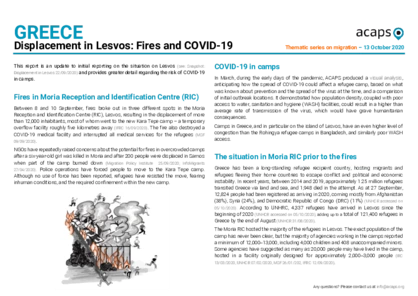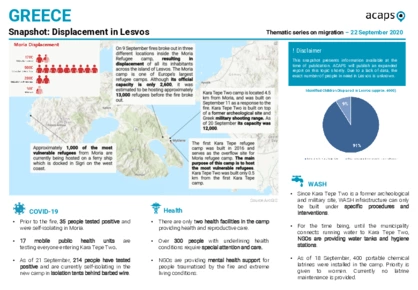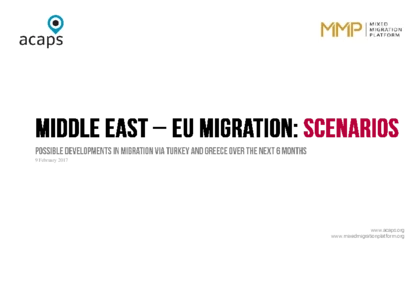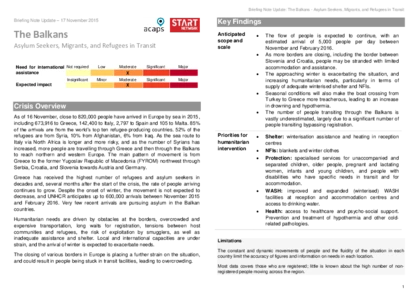Latest updates on country situation
09 April 2025
On 7 April 2025, malnutrition cases were reported among asylum seekers in Greece’s closed controlled access centres (CCACs). These cases underscore what several humanitarian and human rights organisations have been reporting on food assistance restrictions imposed by CCAC authorities leading to food insecurity and affecting the basic and indispensable human rights of asylum seekers and migrants. Médecins Sans Frontières has identified six children who had arrived from Syria and Afghanistan in the last two to three months needing immediate help for severe or moderate acute malnutrition in the Samos CCAC on the eastern Aegean Island. It remains unclear whether they were malnourished upon arriving. The inadequacy of healthcare provision at the camps further aggravates the humanitarian conditions at CCACs, as some camps have lacked state-appointed doctors for years, relying solely on ad hoc volunteer doctors from local hospitals. (MSF 07/04/2025, OHCHR 03/07/2023, ABC 07/04/2025)
06 December 2023
The Samos Closed Controlled Access Centre, which hosts asylum seekers in Greece, is experiencing overcrowding, which is putting pressure on the food, health, and WASH services that those living in the facility need. As at early December 2023, there were more than 3,500 people staying at the centre, a significant increase from 500 in early July. Besides having limited access to basic services, some asylum seekers experience detention-like conditions for up to one month before getting access to legal assistance as the authorities check their documents. Greece is a transit and destination country for asylum seekers travelling to Europe, mostly from East Africa, the Middle East, and South Asia. As at November 2023, over 42,340 refugees, asylum seekers, and migrants in an irregular status had arrived in Greece. Newly arrived asylum seekers usually struggle to find adequate shelter and livelihood. (TNH 04/12/2023, UNHCR accessed 06/12/2023, CBC 20/11/2023)
16 June 2023
On 14 June 2023, a boat carrying 400–750 migrants capsized in Greek waters. The boat was on its way to Italy from eastern Libya. As at 20 June, 100 people had been rescued and 78 bodies retrieved. Up to 500 are still missing. The boat was carrying hundreds of Pakistanis and dozens of Egyptians, Syrians, and Palestinians. The Central Mediterranean migration route from North Africa to Italy and Malta is the deadliest migration route in the world, with more than 1,060 people already missing in 2023 before the 14 June incident. According to IOM, as at 7 June, more than 74,000 migrants had reached Europe in 2023, with the majority arriving in Italy through the sea from the Middle East and West Africa, fleeing wars, conflicts, discrimination, and dire economic conditions. In Europe, migrants struggle to find adequate shelter and livelihoods aside from facing discrimination. (Al Jazeera 19/06/2023,
IOM accessed 20/06/2023,
UNICEF et al. 08/11/2019)
current crises
in
Greece
These crises have been identified through the INFORM Severity Index, a tool for measuring and comparing the severity of humanitarian crises globally.
GRC002 - International Displacement
Last updated 12/11/2025
Drivers
International Displacement
Crisis level
Country
Severity level
2.1 Medium
Access constraints
0.0
Analysis products
on
Greece
12 June 2024
Greece: humanitarian access & conditions along the eastern Mediterranean mixed migration route
DOCUMENT / PDF / 2 MB
This report aims to provide an overview of the protection and humanitarian needs and challenges along the mixed migration route in Greece. It also aims to provide an overview of the barriers hindering humanitarian access and response to the mixed migration crisis in the country.
Attached resources
13 October 2020
Greece: Fires and COVID-19 caused displacement in Lesvos
DOCUMENT / PDF / 685 KB
This report is an update to initial reporting on the situation on Lesvos (Displacement in Lesvos 22/09/2020) and provides greater detail regarding the risk of COVID-19 in camps. Between 8 and 10 September, fires broke out in three different spots in Lesvos, resulting in the displacement of more than 12,000 inhabitants.The fire also destroyed a COVID-19 medical facility and interrupted all medical services for the refugees.
22 September 2020
Greece: Displacement in Lesvos
DOCUMENT / PDF / 398 KB
On 9 September fires broke out in three different locations inside the Moria Refugee camp, resulting in displacement of all its inhabitants across the island of Lesvos. The Moria camp is one of Europe's largest refugee camps. Although its official capacity is only 2,600 it was estimated to be hosting approximately 13,000 refugees before the fire broke out.
09 February 2017
Middle East - EU migration: Scenarios
DOCUMENT / PDF / 933 KB
ACAPS and the Mixed Migration Platform have produced a new set of Middle East–EU migration scenarios, outlining possible developments in migration via Turkey and Greece over the next six months. The report outlines triggers that could drive these scenarios, as well as the impact and humanitarian consequences of each scenario.
18 March 2016
The Balkans: Asylum Seekers, Migrants, and Refugees in Transit
DOCUMENT / PDF / 777 KB
As of 16 November, close to 820,000 people have arrived in Europe by sea in 2015. 85% of the arrivals are from the world’s top ten refugee-producing countries. As the sea route to Italy via North Africa is longer and more risky, and as the number of Syrians has increased, more people are travelling through Greece and then through the Balkans to reach northern and western Europe.






